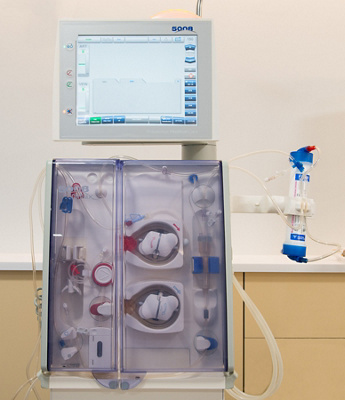The dialysis station

The dialysis station covers all stages of effective, safe and flexible treatment. It consists of the dialysis machine, also known as a dialysis generator, the filter or “artificial kidney”, the supply of ultra-pure water and dialysate, and the bicarbonate input.
It allows production of dialysate, the blood-purifying liquid, the composition of which can be modified to adapt to each patient.
It can also be used for blood circulation and contact with the dialysate through the filter, allowing purification of toxins.
The Cecil Dialysis Centre currently includes 21 haemodialysis stations, which can serve a total of around 80 patients. The various different parameters for each patient are saved permanently by the machine, ensuring quality and safety of treatment.
Ultra-pure water
The ultra-pure water is used as the basis for producing the dialysate, the blood-purification liquid. Stripped of all electrolytes and perfectly sterile, it meets strict bacteriological criteria that are checked each month. It is produced from tap water from the town of Lausanne.
Ultra-pure water is produced in different stages: filters initially eliminate particles and bacteria, a softener eliminates the cations such as calcium and magnesium, then the double-osmosis system ensures that electrolytes are completely eliminated.
An individual 4-hour dialysis treatment consumes about 180 litres of ultra-pure water. Every day, the production system generates between 5,000 and 8,000 litres of ultra-pure water.
The acidic solution
The acidic solution produced in the place of manufacture contains the main electrolytes that make up the dialysate, namely sodium, potassium, chlorine, magnesium and glucose. It is made from ultra-pure water and a specific gel by a central unit called GRANUMIX®.
After production, the solution is stored and preserved. The central unit distributes this solution to all the dialysis machines, facilitating technical functioning while limiting waste.
